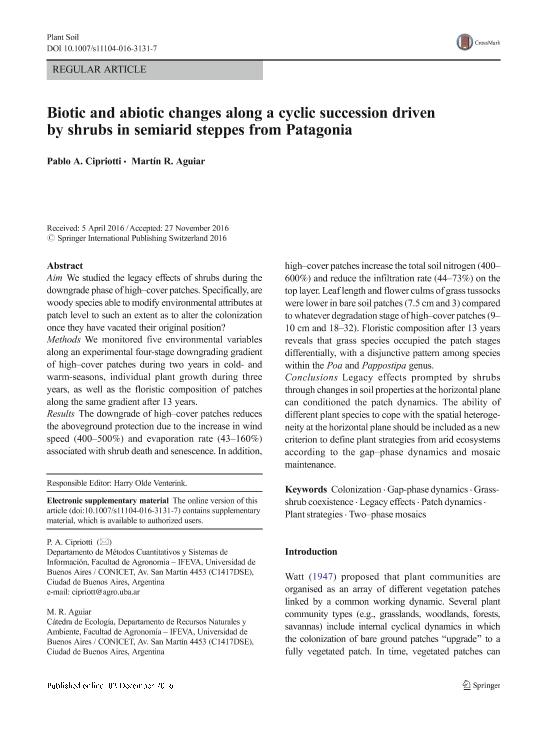Mostrar el registro sencillo del ítem
dc.contributor.author
Cipriotti, Pablo Ariel

dc.contributor.author
Aguiar, Martin Roberto

dc.date.available
2018-06-22T15:31:54Z
dc.date.issued
2017-05
dc.identifier.citation
Cipriotti, Pablo Ariel; Aguiar, Martin Roberto; Biotic and abiotic changes along a cyclic succession driven by shrubs in semiarid steppes from Patagonia; Springer; Plant and Soil; 414; 1-2; 5-2017; 295-308
dc.identifier.issn
0032-079X
dc.identifier.uri
http://hdl.handle.net/11336/49641
dc.description.abstract
Aim: We studied the legacy effects of shrubs during the downgrade phase of high–cover patches. Specifically, are woody species able to modify environmental attributes at patch level to such an extent as to alter the colonization once they have vacated their original position? Methods: We monitored five environmental variables along an experimental four-stage downgrading gradient of high–cover patches during two years in cold- and warm-seasons, individual plant growth during three years, as well as the floristic composition of patches along the same gradient after 13 years. Results: The downgrade of high–cover patches reduces the aboveground protection due to the increase in wind speed (400–500%) and evaporation rate (43–160%) associated with shrub death and senescence. In addition, high–cover patches increase the total soil nitrogen (400–600%) and reduce the infiltration rate (44–73%) on the top layer. Leaf length and flower culms of grass tussocks were lower in bare soil patches (7.5 cm and 3) compared to whatever degradation stage of high–cover patches (9–10 cm and 18–32). Floristic composition after 13 years reveals that grass species occupied the patch stages differentially, with a disjunctive pattern among species within the Poa and Pappostipa genus. Conclusions: Legacy effects prompted by shrubs through changes in soil properties at the horizontal plane can conditioned the patch dynamics. The ability of different plant species to cope with the spatial heterogeneity at the horizontal plane should be included as a new criterion to define plant strategies from arid ecosystems according to the gap–phase dynamics and mosaic maintenance.
dc.format
application/pdf
dc.language.iso
eng
dc.publisher
Springer

dc.rights
info:eu-repo/semantics/openAccess
dc.rights.uri
https://creativecommons.org/licenses/by-nc-sa/2.5/ar/
dc.subject
Colonization
dc.subject
Gap-Phase Dynamics
dc.subject
Grass-Shrub Coexistence
dc.subject
Legacy Effects
dc.subject
Patch Dynamics
dc.subject
Plant Strategies
dc.subject
Two–Phase Mosaics
dc.subject.classification
Otras Ciencias Biológicas

dc.subject.classification
Ciencias Biológicas

dc.subject.classification
CIENCIAS NATURALES Y EXACTAS

dc.title
Biotic and abiotic changes along a cyclic succession driven by shrubs in semiarid steppes from Patagonia
dc.type
info:eu-repo/semantics/article
dc.type
info:ar-repo/semantics/artículo
dc.type
info:eu-repo/semantics/publishedVersion
dc.date.updated
2018-06-19T15:52:09Z
dc.identifier.eissn
1573-5036
dc.journal.volume
414
dc.journal.number
1-2
dc.journal.pagination
295-308
dc.journal.pais
Alemania

dc.journal.ciudad
Berlín
dc.description.fil
Fil: Cipriotti, Pablo Ariel. Consejo Nacional de Investigaciones Científicas y Técnicas. Oficina de Coordinación Administrativa Parque Centenario. Instituto de Investigaciones Fisiológicas y Ecológicas Vinculadas a la Agricultura. Universidad de Buenos Aires. Facultad de Agronomía. Instituto de Investigaciones Fisiológicas y Ecológicas Vinculadas a la Agricultura; Argentina. Universidad de Buenos Aires. Facultad de Agronomía. Departamento de Métodos Cuantitativos y Sistemas de Información; Argentina
dc.description.fil
Fil: Aguiar, Martin Roberto. Consejo Nacional de Investigaciones Científicas y Técnicas. Oficina de Coordinación Administrativa Parque Centenario. Instituto de Investigaciones Fisiológicas y Ecológicas Vinculadas a la Agricultura. Universidad de Buenos Aires. Facultad de Agronomía. Instituto de Investigaciones Fisiológicas y Ecológicas Vinculadas a la Agricultura; Argentina. Universidad de Buenos Aires. Facultad de Agronomía. Departamento de Recursos Naturales y Ambiente. Cátedra de Ecología; Argentina
dc.journal.title
Plant and Soil

dc.relation.alternativeid
info:eu-repo/semantics/altIdentifier/doi/http://dx.doi.org/10.1007/s11104-016-3131-7
dc.relation.alternativeid
info:eu-repo/semantics/altIdentifier/url/https://link.springer.com/article/10.1007/s11104-016-3131-7
Archivos asociados
